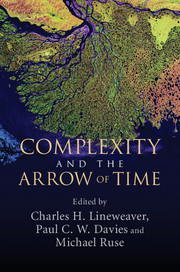Book contents
- Frontmatter
- Contents
- Author biographies
- Part I Introduction
- Part II Cosmological and physical perspectives
- Part III Biological complexity, evolution, and information
- 7 Life: the final frontier for complexity?
- 8 Evolution beyond Newton, Darwin, and entailing law: the origin of complexity in the evolving biosphere
- 9 Emergent order in processes: the interplay of complexity, robustness, correlation, and hierarchy in the biosphere
- 10 The inferential evolution of biological complexity: forgetting nature by learning to nurture
- 11 Information width: a way for the second law to increase complexity
- Part IV Philosophical perspectives
- Index
- References
9 - Emergent order in processes: the interplay of complexity, robustness, correlation, and hierarchy in the biosphere
from Part III - Biological complexity, evolution, and information
Published online by Cambridge University Press: 05 July 2013
- Frontmatter
- Contents
- Author biographies
- Part I Introduction
- Part II Cosmological and physical perspectives
- Part III Biological complexity, evolution, and information
- 7 Life: the final frontier for complexity?
- 8 Evolution beyond Newton, Darwin, and entailing law: the origin of complexity in the evolving biosphere
- 9 Emergent order in processes: the interplay of complexity, robustness, correlation, and hierarchy in the biosphere
- 10 The inferential evolution of biological complexity: forgetting nature by learning to nurture
- 11 Information width: a way for the second law to increase complexity
- Part IV Philosophical perspectives
- Index
- References
Summary
A large part of the structure that is recognized and understood in the vacuum (Weinberg, 1995; Weinberg, 1996) and in condensed matter (Ma, 1976; Mahan, 1990; Goldenfeld, 1992) is the result of a hierarchy of phase transitions in either quantum-mechanical or thermodynamic systems. Each phase transition creates a form of long-range order among components of the system that in the absence of the phase transition could fluctuate independently. To the extent that the phase transitions are nested or sequential in order of decreasing energy or increasing spatial scale, both of which correlate with increasing age of the universe, the progression through the sequence and the accretion of additional forms of long-range order constitute a progression of complexity.
In this chapter I argue that phase transition continues to be the appropriate paradigm in which to understand the emergence of the biosphere on Earth, and that at least some universal patterns in life should be understood as what are called the order parameters (Goldenfeld, 1992) of one or more such transitions. The phase transitions that formed the biosphere, however, are dynamical transitions rather than equilibrium transitions, and this distinction requires a different class of thermodynamic descriptions and leads to some striking differences in gross phenomenology from what has become familiar from equilibrium systems.
- Type
- Chapter
- Information
- Complexity and the Arrow of Time , pp. 191 - 223Publisher: Cambridge University PressPrint publication year: 2013
References
- 4
- Cited by

